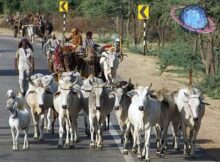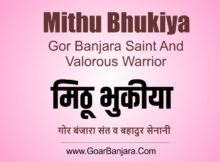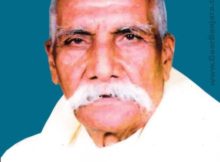ANCIENT HISTORY OF GOR BANJARAS
Written by: Prof. MOTIRAJ RATHOD (Aurangabad, Maharashtra)
Gor Banjaras and the Indus Culture
Gor is one of the ancient vamshas in the world. Its history dates back to 5-6 thousand years. The references about Gor Vamsha are found in Greek civilization up to Harappa and Mohenjodaro. Even proof has been found regarding presence of a civilization here 4500 years prior to Harappa civilization.
This civilization is the Gor civilization. It is a subject of research as to how the Gor civilization remained unknown for so many years. With a detailed study it can be concluded that the Gor Vamshi tribe might have been the originator of the Indus civilization.
The tradition of chronicling ancient history started here with the entry of British in India. Till that time we were oblivious about the ancient history of India. The world had a wrong perception till 20th century that India is highly backward country with no civilization of its own. The treasure of ancient civilization was found when the digging works for Lahore-Multan Railway started in 1921. This was the Indus civilization. Based on the ruins of this civilization the world accepted the fact that India was indeed a developed civilization in the past. Even the Indus civilization was regarded as superior to the civilizations of Egypt, Greek, Mesopotamia, Bobalia, Sumerian, Taigras and China.
The ancientness of the Indian history was taken from the Rigveda period. But due to the discovery of Indus civilization this history was dated back by 3 thousand years. It cannot be told for sure when the references about history, based on the studies and research, will change.
The tribe, which was known as Banjara, Lamani, and Lambada till 20th century, they are now being proved as Kshatriya Gorvamshiya tribe. Pundit Gaurishankar Oza did pioneering work in unearthing their unknown history. Till that time Gor Banjaras were ignorant about their own history. During the course of these findings it came to light that Gor culture of Gorvamshiyas is responsible for the origin of Indus culture.
Gor culture has made an impact on the ancient cultures of the world. Even today tribes like Gorvamshiya are found in some 60 countries. Their world body is known as Roma Gypsies. There is almost 90% similarity as regards their language, costumes, lifestyle and food habits. They treat Gorvamshiya Banjaras as their brethrens. A world conference of Banjara Romas was held in Germany in 1980. A delegation of Gor Banjaras from India in the leadership of Ramsingh Bhanawat was present in the conference.
The other Gorvamshiyas in the world treat India as their homeland. A comparative research study is underway at the global level. Perhaps the Gor culture may prove instrumental in changing the ancient history of the world, once again.
Normally two instruments are used while writing about the ancient history. One of them is physical i.e. archeological source and the other one is oral or unwritten. The things which were buried in the earth in the course of time have been excavated by us and based on them we recreated the Indus culture. But it is likely that many a precious and fragile art crafts might hive been lost in the mean time. We have drawn some conclusions based on the artcrafts and structures found in the excavation.
In all the archeological findings do not give a clear-cut picture of the times. We cannot claim to recreate the glorious past solely on their basis. We also need to take into account the human emotions, behavioural patterns, community as well as independent human values, chastity and overall public life for depicting the history. For this the oral inputs in practice are important and they are well preserved with the Gor Banjaras till date. Their study will lead us to know the complete history of Gor culture as follows.
Live ancient pre-Indus references
Historically humans were living in groups. Even today such groups are found and they are called as Tanda (Caravan). The Banjara settlement is not called as a village rather referred to as Tanda only. Banjara Tandas are also found in Afghanistan and Pakistan. The Gor Banjara tribe had devised rules for game when they used to hunt animals for food. Today they are still in vogue in some Tandas.
The Gorvamshi are witness to the hunting stage of early humans dating back to thousands of years. Later in the state of domestication of animals Banjaras was an important tribe in rearing the cows and protecting them. They took their ethnic name from this occupation. ‘Go’ means cow and ‘ra’ means the protector, hence ‘Gor.’ References regarding people engaged in trading by loading their goods on oxen since 4500 years ago are found. As they were engaged in trade they came to be known as Banjara.
I think that the word Banjara might have come from Arabic or Persian language. The meaning of the Hindi word ‘Banaj’ means trade. Therefore a person engaged in Banaj was called as Banjara. These people were engaged in trade since pre-Indus times till the arrival of British in India. Their tribe might have been engaged in trade initially and later adopted goods transport as their occupation.
This means the tribe is endowed with an ancient history dating back from wild gaming stage to right up to pre-Indus agrarian stage. Their origin might have been buried during the Indus period. Numerous proofs are found in the Vedic period in this regard.
Culture with a different tradition
Gorvamshiyas had a unique yet independent culture. They have preserved their unique tradition of livelihood as also independent public life. It is very much evident in their lifestyle, food habits, festivals, rituals, worship, use of cosmetics, likes and dislikes, dances, songs, language, clothing, literature among the Tanda life.
The design of city layout found in Indus culture and those of two-storey structures are referred to in the Banjara folk literature. The reason behind this culturally developed tribe adopting Tanda culture later might be the Mother Nature. The Nature, which the Gors were worshipping, was responsible for destruction of the whole culture. Hence they might have reconciled to the thought of living in Tandas instead of building well-designed cities and dwellings.
They might have taken this change as their fate. They had no more faith in creating physical wealth and settling down at one place. It gave origin to their Tanda culture. They considered it as against the fate to create physical households and hence refrained from such an act but the openness and greatness of their mind is still reflected in their public dealings and life. Tanda is the symbol of their life.
Tanda Jury Board
The Tanda culture gave rise to an independent arrangement. In order to maintain cordial and friendly relations among the Tanda members and to look after their well being a Jury board was formed. The head of this board is called as Nayak. He was almost regarded as a King of the Tanda. To help him in his work another official called Karbhari is also appointed.
The karbhari was to give suggestions to the Nayak for well control of the Tanda and preserve the culture. The common member in the Tanda is called as ‘Asami.’ These ordinary people have the right to remove even the Naik from the post. The roots of democracy are found in the Tanda system.
The Tanda bestows equal voting right to all. With it the ordinary men can remove any dictatorial, oppressive type of Naik. The Naik was regarded as a king but at the same time he was subjected to work according to wishes of the people.
The ruler of England adopted the same method afterwards. This arrangement of democracy once in vogue in the Tanda culture has been accepted the world over. Thousands of such Tandas exist today in our country.
The judicial system of the Tanda – Nasab
The Tanda culture originated its own system to decide on its matter and to give justice to its members. The internal system of the Tanda was based on values and justice. The Tanda Jury Board was on guard against any injustice to any member.
After hearing both sides in detail the Naik and Karbhari used to consult all concerned before taking a decision. If the decision of the Naik is unacceptable then there was provision for further appeal. The case would be tried in front of the Jury Boards of other 4-5 Tandas and their decision was binding on both the parties. Otherwise the member was outcast by the Tanda.
This was the highest punishment one would get. Nobody continued any kind of dealing with the person. This made quite difficult for the person to live in the Tanda. He was incepted once again after 2-4 years with a due apology rendered by him. Normally there was no practice of registering any complaint outside the Tanda system. Approaching the courts & offices was considered as a sin.
The Tandas have gifted this legal system of solving local problems to the world. Today’s public courts (Loknyayalayas) are based on the Tanda system of justice.
Worshipping
Gor Banjaras were worshippers of Nature since ancient times. The Sun, Wind, Fire, Water and the Earth were their gods. During the festival of Diwali and Holi, ‘Pitrupooja’ is performed. It is known as ‘Dhabukar.’ In it, sweets are offered to the fire in the fireplace. Also wheat rice and curry are offered in the name of saints and great men.
These items are buried in the earth by digging a small pit in front of the house. Only the men in the Tanda prepare food for these offerings. Killing a goat is the third offering. By applying a thin layer of cow dung mixed in water a small place on the right side of the house is cleaned.
A design of the earth and its four parts showing four continents are drawn with the help of Jowar flour in the cleaned place. It is called as ‘Choki.’ A bronze pot filled with water is kept in the center of the Choki and a small stick of Neem leaves is kept inside it. This is known as ‘Jalkumbh.’ After sacrificing the goat the head of the animal with its legs kept inside its mouth is placed in front of the Choki.
Then all the male and female members perform a common prayer. Normally this ritual is performed in the evening. The place of the worship is towards the East while the worshipper prays with folded hands facing the West direction.
Lifestyle – Clothing
Gor Banjaras are the co-coordinators of the world culture. They are the only tribe trotting the globe for trade since prior to Indus culture. It is a matter of research to find out which ideology was exchanged by them with the world. It is more important than the travelogues of foreign visitors Fa Hein (399-411 AD) and Hue-n-Tsang (614-616 AD).
The Gor travelers were used to come in contact for 8 months in a year and hence claim a lion’s share in enriching the Indian culture. The lifestyle, food habits of these people might have come under the influence of western culture but the uniqueness in their clothing and choices of food are preserved through generations as a traditional heritage. Consuming non-vegetarian food and drinks are still practiced as part of religious ritual.
Gaming is the preferred hobby of Gor Banjaras. It is a kind of adventure sport for them. They have also prescribed rules of the game. They make the animal alert before killing him. They have fond of non-vegetarian food and drinks.
All their festivals are celebrated invariably with these two items. Gor Banjaras do not collect much physical wealth but prefer to enjoy the joys of life to the fullest and in a whole-hearted manner. Dancing and singing are very much essential in their life. It is their forte of life.
“ये जीवडारो भरोसे केय जायनी आये जलम में कुद रम लेणु खालेनु पिलेनु पेर लेणु ये जीवडारो भरोसे केय जायनी”
The principle behind this is when you are born in human life it is imperative to live the life to the fullest. There is no guarantee about life. It is truly a tribe thriving with life. The people are rich in tastes and habits and artistic in nature. They take pleasure in doing different things and attract others. Some of their remnants found in Indus culture are still preserved by them.









